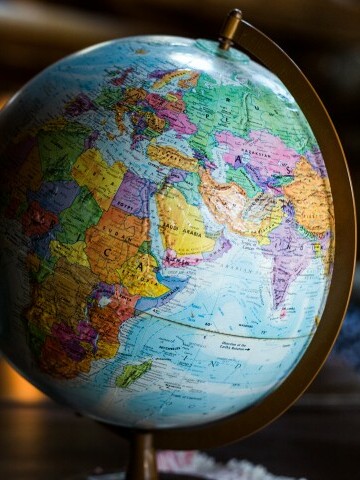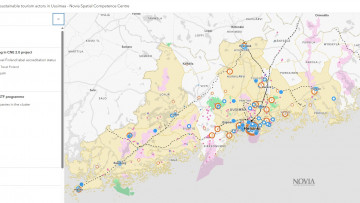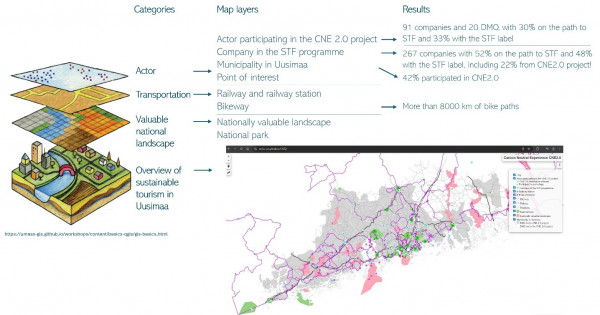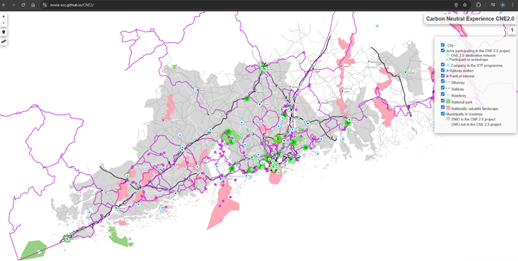
Bloggar
Using spatial data to highlight sustainable tourism paths in Uusimaa

International and national frameworks and commitments define today’s tourism landscape in the fight against climate change. The Glasgow Declaration on Climate Action in Tourism, launched in 2021 during the United Nations Climate Change Conference (COP26), is implemented and supported notably through the One Planet programme on Sustainable Tourism[1] and works towards cutting tourism emissions to reach Net Zero by 2050.
Finland is no exception and is actively pursuing being a trailblazer in sustainable development, aiming to become the most sustainably growing tourism destination in the Nordic countries[2]. Hence, when signing the Glasgow Declaration in 2022, Visit Finland has committed to a Climate Action Plan[3]. The same year, the Ministry of Economic Affairs and Employment also published the national tourism strategy (2022-2028), supporting sustainable growth and renewal in Finnish Tourism2. In 2023, the Sustainable Travel Finland (STF)[4] programme, as a part of Finland sustainability initiatives, was launched by Visit Finland. The programme aims to support tourism companies and destinations to establish sustainable practices and then being recognized through the STF label awarded[5].
In Uusimaa, the Carbon Neutral Experience – CNE (2021-2023) and CNE 2.0 (2024-2025)[6], [7] – projects focused on improving the understanding of carbon footprint and sustainable tourism in the region, developing competence within the business sector, and supporting sustainable growth in the tourism services and industries.
Several goals were targeted, notably building a network of actors including experts from municipalities, universities, and businesses, and utilizing data and new working methods to advance sustainable tourism. The projects brought companies and destination marketing organizations (DMO[8]) together to work on their way towards carbon neutrality for a just transition, responding to SDG 11 “Sustainable cities and communities”. Workshops and seminars were then organized to tackle those goals. To improve self-evaluation, an essential step for the STF label, actors were invited to learn about carbon footprint and emission calculations, sustainable networks, circular economy, regenerative tourism, and interactive mapping. Novia Spatial Competence Centre (SCC) was mandated for this last component as spatial data give the context needed for better decision making and maps help to visualize that context.
For the CNE 2.0 project, the purpose of the maps was to give an overview of responsible companies and destinations in Uusimaa. “Maps talk for themselves” and are designed to be an easy tool for destinations and companies. They offer a unique way to browse like-minded entrepreneurs to strengthen current network, and identify where the potential synergies are. The maps also help to understand if there are links and processes explaining the reasons why (and why not) companies and destinations made such choice to become more responsible and what to do to promote that choice elsewhere. By a glance, it is easy to identify hot and cold spots, and consequently where the effort should be concentrated or facilitated. Finally, by their nature, maps show how clients (tourists, customers) travel between those spots to eventually bringing the focus on making those routes also more sustainable.
In a map, information is presented in layers. Several layers of information have been added as wished according to feedback received, tailored to the users, and focused on Uusimaa (picture 1).

Picture 1: Diagramme of the map components
The category Actor features several layers of tourism industries, companies and DMO being active, participating or showing sustainable behaviour. Those are primary actors advocating and showing the path to sustainable tourism. The category Transport has been added as it represents an important contributor in terms of emissions within the tourism industries[9], notably private vehicle use to and from destinations, as well as movement within the destination itself[10]. However, the paradox between promoting tourism while alleviating travelling justified adding low-emission transport such as train at a national scale and bicycle trails. Finally, the category Valuable national landscape includes national parks[11] and nationally valuable landscape areas (VAMA[12]) representing regional touristic motors[13]. Indeed, in Finland, nature-based tourism serving both nature conservation and recreational spaces have gained much interest in the last decades and offer a strong focus on sustainable practices (Puhakka, 2008[14]). They are also responsible for emissions in attracting tourist traffic while not directly generating any revenue (hence no possibility of offsetting or regulating emissions produced).
From the layers were built interactive maps, accessible freely via a simple link (pictures 2 and 3). The maps are currently supported and maintained by Novia SCC. One of the maps has been built with an open software and hosted on an open platform (picture 2) while the other map has been built on a proprietary platform and offer several options for the user, including adding potential actors via a Contribute button or filtering layers according to the information on which the user wants to focus (picture 3). When exploring the maps, information about each category and details on the information are available, including their STF status and other relevant accreditations (e.g., Green Key[15], Glasgow Declaration[16] , Sustainable Tourism[17], Good Travel Seal[18], HINKU[19]), or their respective sources. Project-specific information is also available such as companies and DMO’s carbon footprint and emissions.

Picture 2: https://novia-scc.github.io/CNE2/

Picture 3: https://arcg.is/1j0q482
Finally, an app has also been created to ease the contribution process and allowing the user by a simple click to add one’s suggestion.
At a glance, the maps display different spatial patterns that can be lifted depending on the scale the data are analysed. Amongst actors, across municipalities, regardless of industries, the maps allow to identify regional clusters and gaps, highlighting networks, flows and bottlenecks, disparities and common struggles.
The results of the spatial analysis of those maps and consequent trends have been reported, discussed, and paths to further investigation identified. Those would support, on one hand, touristic authorities to boost their industries, and on the other hand, they would encourage touristic actors to board or continue their meaningful journey towards sustainability notably through certification and innovation. It is now in the hands of CNE3.0 to build on them: ultimately, reducing tourism-related emissions requires a combination of individual choices, business practices and systemic changes in transportation infrastructure and policies.
More information are available on the extensive report.
Carbon Neutral Experience 2.0 project partners are
UAS Novia, UAS Haaga-Helia and Posintra.
CNE 2.0 project is financed by Uudenmaanliitto and ended in July 2025.
13 municipalities have committed to the project: Helsinki, Raasepori, Tuusula, Porvoo, Hyvinkää, Espoo,Vantaa, Hanko, Sipoo, Lohja, Siuntio, Inkoo, Nurmijärvi.

[1] https://www.oneplanetnetwork.org/programmes/sustainable-tourism/glasgow-declaration, 2021
[2] https://tem.fi/en/finland-tourism-strategy, 2022
[3] https://www.visitfinland.fi/4ac28d/globalassets/visitfinland.fi/vf-julkaisut/2023/visit-finland-climate-action-plan-2023.pdf
[4] https://www.visitfinland.fi/en/liiketoiminnan-kehittaminen/vastuullinen-matkailu/sustainable-travel-finland, 2023
[5] https://www.visitfinland.fi/suomen-matkailudata/sustainable-travel-finland-tilastot, 2025
[6] https://www.cne.fi/en/home/
[7] https://www.novia.fi/fi/tki/projektit/carbon-neutral-experience-2-0-
[8] DMO are entities responsible for touristic activities within the destination. A destination is a place for tourists to visit and stay such as a municipality, a city, or a site (e.g., Visit Raseborg or Fiskars Village).
[9] https://www.visitfinland.fi/4ac26e/globalassets/visitfinland.fi/vf-julkaisut/2024/state-of-sustainable-tourism-2023.pdf
[10] https://www.climateguide.fi/articles/tourism-and-recreation-mitigation/, 2025
[11] https://www.lipas.fi/etusivu, 2025
[12] https://www.syke.fi/en/environmental-data/downloadable-spatial-datasets#nationally-valuable-landscapes-vama
[13] https://www.ymparisto.fi/en/nature-waters-and-sea/landscape/nationally-valuable-landscape-areas, 2025
[14] Puhakka, Riikka (2008). Increasing role of tourism in Finnish national parks. Fennia 186: 1, pp. 47–58. Helsinki. ISSN 0015–0010.
[16] https://www.oneplanetnetwork.org/programmes/sustainable-tourism/glasgow-declaration/signatories
[17] https://www.oneplanetnetwork.org/countries/europe-and-central-asia/finland
[18] https://goodtravel.guide/
[19] https://hiilineutraalisuomi.syke.fi/hinku/verkoston-jasenet/#hinku-kunnat
The blogpost has been reviewed by Novia's editorial board and accepted for publication on 30.9.2025.![]()
Bioekonomi
Blogginlägg som är granskat av Novias redaktionsråd är utmärkta med nyckelordet "Granskat inlägg".
Vi följer CC-BY 4.0 om inget annat nämns.
Ansvarsfriskrivning: Författaren/författarna ansvarar för för fakta, möjlig utebliven information och innehållets korrekthet i bloggen. Texterna har genomgått en granskning, men de åsikter som uttrycks är författarens egna och återspeglar inte nödvändigtvis Yrkeshögskolan Novias ståndpunkter.
Disclaimer: The author(s) are responsible for the facts, any possible omissions, and the accuracy of the content in the blog.The texts have undergone a review, however, the opinions expressed are those of the author and do not necessarily reflect the views of Novia University of Applied Sciences.